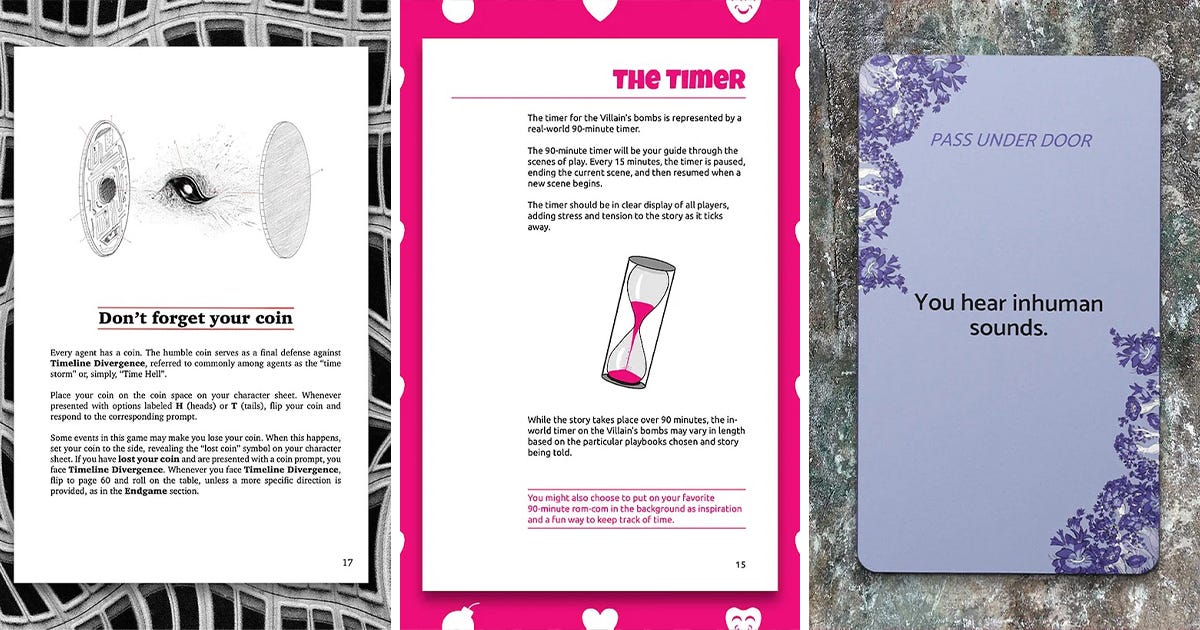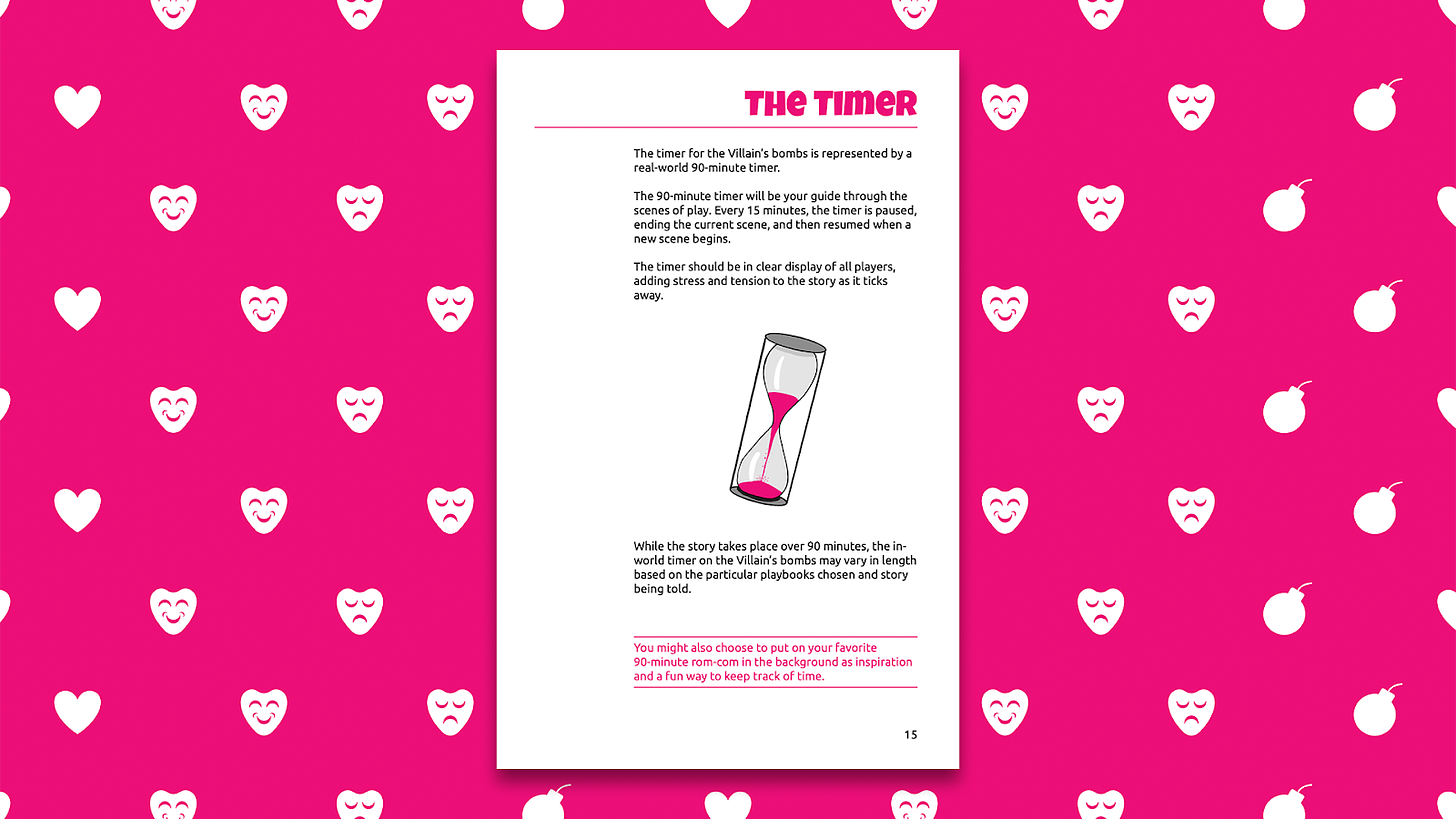Opening the Door to Diegetic Design
What Project ECCO, RCDB, and The Time We Have Have in Common
I recently had the chance to sit down with Thomas Manuel on the Yes Indie’d podcast for a conversation about my latest game, The Time We Have. In that chat, Thomas helped me connect something my three biggest games all have in-common: diegetic objects.
These are objects used in the game’s mechanics that have a representation in the real world that is the same or similar to its place in the fiction.
I’m reminded of why I fell in love with DIE: The RPG. Kieron Gillen performs a magical transformation of the beloved polyhedral set, making each into a diegetic object of power that not only changes your fictional character into a Paragon but changes you into your character.
When Thomas and I spoke, I hadn’t put together this commonality of my work but it is something I love about each of my games.
For Project ECCO, this is the planner (as well as the coin), used by you the player and your character, the agent.
In Rom Com Drama Bomb, this is the timer, counting down to the end of the game and the explosion of the bombs attached to your characters’ hearts.
In The Time We Have, a physical door is required for play, separating the players and the fictional survivor from the infected zombie-to-be.
Here are some tips for putting diegetic objects into your next design.
1: Everyday for Everyone
The best objects to make diegetic are those that your players are going to have access to and familiarity with—something they see or interact with in their everyday lives.
For a time travel game, I could have made a bespoke document that represents a full-year (okay, yes. I did also do that) but there is already an object that many people use to track time: planners. I knew that there were many people like me who had year planners collecting dust purchased with the best intentions of “this year being different.”
2: The Right Amount of Abstraction
Do you want your object to have a 1:1 translation between real world and fiction? For a game like The Time We Have, the Door is a near exact translation from real world object to in-fiction object. Players have the space to describe things about it that are different in the story but ultimately it is a door separating two people in both worlds.
On the other hand, in Rom Com Drama Bomb, the timer is more abstracted in its translation. It is always 90 minutes in the real world but that restriction is removed from the fiction.
3: Use It!
The last and most key tip for diegetic objects in your game’s design: make sure it is used in the game. Make it fun. Make it part of play. Give your players something to do with it that reinforces its translation from real world to in-fiction.
For The Time We Have, I could have stopped at having players sit on opposite sides of a door, letting the separation alone be a tool for immersion in set up. But it is a stronger inclusion for how it is engaged with throughout play, with perception cards being specifically slid under the door and the safety mechanic being knocks on the door.
What other TTRPGs do you love that incorporate real objects from the game world into game play?
Consider an object that you interact with every day. How might you bring that into both the mechanics and the fiction of your next game? Or, if you’re in a rut, grab an object and force yourself to make a game where it is diegetic. You might discover something great.
—Elliot
Check out Project ECCO, Rom Com Drama Bomb, and The Time We Have
Changes to Our Patreon!
Starting December 1st the My First Dungeon Patreon will become the MANY SIDED MEDIA PATREON!
That means our Patreon will be your one-stop shop for all the bonus content for both My First Dungeon and Talk of the Table (and maybe some more shows in the future).
For more information check out our full breakdown on our Patreon.
—Brian, Shenuque, Elliot, and Abby
🗞️ News Worthy
Season 1 of Bitcherton has officially launched!
Mothership Month funds 21 projects in under 24 hours.
John Harper releases Deep Cuts, a 118-page expansion for Blades in the Dark.
Dropout releases the “Never Stop Blowing Up” game system for free.
🎲 What We’re Bringing to The Table
🎥 Watch: Bark After Dark: interview with INTERLOPER creator Joel Hines
📚 Read: Leveling up Actual Play Production with Many Sided Media (Rascal)
🎧 Listen: Yes Indie’d: Zombies, Doors, and Objective Immersion (w/ Elliot Davis)
🎙️ New From The Studio
My First Dungeon presents: Paint the Town Red Episode 4 — THE FINALE! (Thursday 11/21)
Talk of the Table (w/ John Harper) — (Monday 11/25)
Bitcherton | Episode 3 with Nathan Yaffe — (Wednesday 11/27)













Fantastic interview on "Yes Indie'D" - congratulations!! I listened to it with bated breath :) I'm very interested in your "not-really-a-larp" game about two brothers during a zombie apocalypse <3
Moreover, this is a very interesting article and a fascinating design direction! This tool is very often used in freeforms, which are generally a format at the intersection of story games, improv, and larp :)
Allow me to make one tiny nitpick :) Technically, if we’re just playing a traditional RPG sitting at the table, and in the fiction of the RPG, our characters are separated by wooden doors, then those doors are already strictly "diegetic objects," because diegetic simply means "existing in the fiction."
In your example, the doors and calendar are transdiegetic objects (being the same object in diegesis as in real world), as opposed to the timer, which I would call a symbolic object (because it abstracts something or simply symbolizes it, like how a pen can symbolize a sword in improv, or four chairs can symbolize a car – but here, the timer is even more of an abstraction).
I’m rooting for the development of your games, podcasts, and projects!